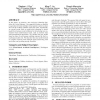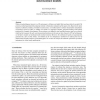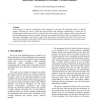202 search results - page 1 / 41 » Modeling collision avoidance behavior for virtual humans |
ATAL
2010
Springer
14 years 21 hour ago
2010
Springer
In this paper, we present a new trajectory planning algorithm for virtual humans. Our approach focuses on implicit cooperation between multiple virtual agents in order to share th...
IVA
2010
Springer
13 years 9 months ago
2010
Springer
We present a velocity-based model for realistic collision avoidance among virtual characters. Our approach is elaborated from experimental data and is based on the simple hypothesi...
CGF
2000
13 years 10 months ago
2000
When articulated figures interact in a 3D environment, collisions are highly likely and must often be avoided. We present a method automatically producing realistic collision-free...
CGF
2002
13 years 10 months ago
2002
In this paper, we describe a method for cloth animation in real-time. The algorithm works in a hybrid manner exploiting the merits of both the physical-based and geometric deforma...
AGENTS
2000
Springer
14 years 2 months ago
2000
Springer
A crowd is not only a group of many individuals. Crowd modelling involves problems that arise only when we focus on crowds. For instance, avoiding collision problems related to a ...



